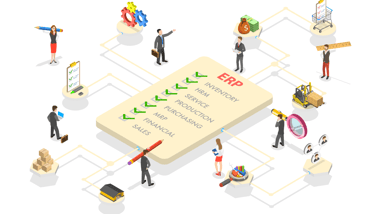The American financial landscape is undergoing a dynamic transformation. Gone are the days of siloed data, manual processes, and reactive decision-making.
Today, a wave of technological advancements is reshaping the finance function, empowering teams to become strategic partners driving organizational growth. In 2024, we're witnessing a clear trend: embracing technology is no longer just an option, it's a necessity for businesses to thrive.
Several factors are driving this tech-driven transformation:
- Evolving regulations: Compliance demands are constantly changing, requiring agile and automated solutions to ensure accuracy and efficiency.
- Data explosion: Businesses generate vast amounts of data, but extracting meaningful insights remains a challenge. Modern financial tools are crucial to unlock this hidden value.
- Global competition: In an increasingly connected world, US businesses must operate with agility and foresight. Data-driven financial planning and analysis (FP&A) helps navigate dynamic market conditions.
-
- Talent shortage: Attracting and retaining skilled finance professionals is a growing concern. The future of finance faces a significant challenge: a decline in the number of accounting graduates entering the workforce. According to a December 2023 article in the CPA Journal, The Accounting Profession is in Crisis, there are several reasons for this decline, including:
-
-
-
-
-
-
- A perception that accounting is a boring career
- Lower compensation compared to other majors like finance and technology
- The burden of a 150-hour requirement to become a CPA
-
-
-
-
-
Technology can automate tasks, freeing up finance teams to focus on higher-value activities.
These challenges present a unique opportunity. By strategically adopting the right technologies, finance teams can unlock a new level of efficiency, accuracy, and data-driven decision-making. Let's explore some key areas where technology is making a significant impact:
1. Cloud-Based Enterprise Resource Planning (ERP) Systems
The cornerstone for modern financial management, cloud-based ERPs like Sage Intacct, Oracle NetSuite, and Microsoft Dynamics offer a centralized platform for managing all financial processes – from accounting and payroll to expense management and reporting. This shift empowers finance teams with:
- Real-time data: Gone are the days of waiting weeks for reports. Cloud ERPs provide instant access to financial data, enabling proactive decision-making.
- Reduced errors and increased efficiency: Automated workflows and data integration significantly minimize manual errors and streamline tasks, freeing up valuable time for analysis.
- Scalability for businesses of all sizes: Smaller businesses can leverage cloud ERP to gain access to sophisticated financial tools without significant upfront costs. Larger organizations benefit from scalable solutions that can grow alongside their operations.
2. FP&A Software
Traditional financial planning often relies on spreadsheets and manual calculations. Modern FP&A software like Limelight provides a robust platform for:
- Flexible budgeting and scenario modeling: Finance teams can create dynamic budgets that adapt to changing market conditions and run "what-if" scenarios to assess potential risks and opportunities.
- Centralized calculations and collaboration: With real-time data and centralized calculations, teams can collaborate effectively and ensure everyone is working from the same information.
- Improved forecasting accuracy: Leverage historical data and current trends to generate realistic forecasts, enabling proactive planning and resource allocation.
3. Business Intelligence (BI) Tools
Modern ERPs generate vast amounts of data, but turning that data into actionable insights remains a challenge. BI tools like Power BI and Domo empower finance teams to:
- Visualize data: Create interactive dashboards and reports that highlight trends and provide a clear picture of financial performance.
- Drill down for deeper analysis: Explore data in detail to identify key drivers of performance and uncover hidden opportunities for improvement.
- Data-driven decision-making: BI tools empower finance teams to move beyond intuition and base their decisions on reliable data and insights.
These are just a few examples of how technology is transforming the US finance landscape. By embracing these tools, finance teams can:
- Become strategic partners: Move beyond basic accounting functions and provide valuable insights that drive business growth.
- Increase efficiency and productivity: Automate tedious tasks and free up time for analysis and strategic planning.
- Improve decision-making: Data-driven insights equip leaders to make informed decisions that optimize performance and mitigate risk.
- Enhance compliance: Automate workflows and ensure adherence to ever-changing regulations.
The US finance landscape in 2024 is dynamic and technology-driven. By strategically leveraging the right technology solutions, finance teams can unlock a new level of efficiency, accuracy, and data-driven decision-making. This transformation empowers finance to become a key driver of business success, ensuring growth and resilience in a competitive market. The future of US finance is undoubtedly forward-looking, and those who embrace technology will be best positioned to navigate the challenges and opportunities that lie ahead.






